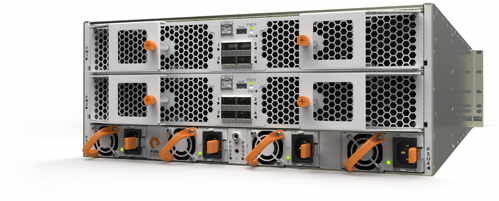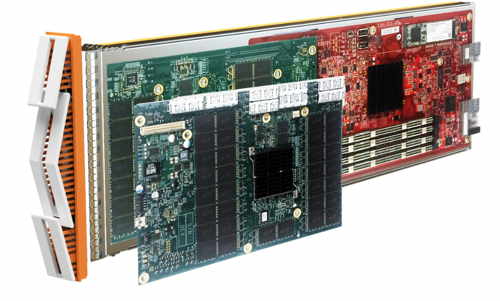Pure Storage Reveals Cloud-Scale All-Flash Data Platform: FlashBlade
8TB and 52TB per blade, up to 1.6PB in 4U, "less than $1/GB usable"
This is a Press Release edited by StorageNewsletter.com on March 21, 2016 at 3:02 pmPure Storage, Inc. announced FlashBlade, an all-flash storage platform designed to store the biggest, fastest data of today and tomorrow.
 FlashBlade is an elastic scale-out system that delivers all-flash performance to multi-petabyte-scale data sets at economics of less than $1/GB usable. Together, FlashBlade and the FlashArray form a complete platform for organizations to build their all-flash cloud.
FlashBlade is an elastic scale-out system that delivers all-flash performance to multi-petabyte-scale data sets at economics of less than $1/GB usable. Together, FlashBlade and the FlashArray form a complete platform for organizations to build their all-flash cloud.
FlashBlade rear
 All-flash storage solutions have already transformed the structured data powering databases, applications and VMs. But unstructured data, both larger and growing faster, is poised for a similar transformation. While the ‘big data’ revolution has shown organizations the potential value dormant in their large pools of unstructured data, traditional unstructured data solutions – legacy NAS filers and scale-out NAS – have remained slow at scale.
All-flash storage solutions have already transformed the structured data powering databases, applications and VMs. But unstructured data, both larger and growing faster, is poised for a similar transformation. While the ‘big data’ revolution has shown organizations the potential value dormant in their large pools of unstructured data, traditional unstructured data solutions – legacy NAS filers and scale-out NAS – have remained slow at scale.
Click to enlarge
 These legacy systems are challenged in several dimensions by demands for data to be both big and fast. First and foremost, they were architected for disk – a slow media. Second, they have limited metadata scale, which constrains performance even when retrofitted with flash. Finally, their scaling approach typically involves partitioning data to nodes, leading to data silos that cause performance bottlenecks and management frustration. FlashBlade addresses these shortcomings with a three-fold value proposition – big, fast and simple.
These legacy systems are challenged in several dimensions by demands for data to be both big and fast. First and foremost, they were architected for disk – a slow media. Second, they have limited metadata scale, which constrains performance even when retrofitted with flash. Finally, their scaling approach typically involves partitioning data to nodes, leading to data silos that cause performance bottlenecks and management frustration. FlashBlade addresses these shortcomings with a three-fold value proposition – big, fast and simple.
While big data increases exponentially, the approach to analytics is growing richer with more complex and highly iterative queries. As a result, scientists, engineers and developers are seeking a new type of storage platform that can deliver fast performance acros a massive expanse of data and connecting clients simply and easily, without the expense and complexity of exotic, high performance legacy systems.
Target workloads for FlashBlade include:
-
Born-digital science and engineering. Whether designing the next-generation chip, simulating airflow over an airplane wing, analyzing weather patterns or teaching a car how to drive itself – organizations are doing it digitally. Today’s scientists and engineers increasingly have limitless compute cores at their disposal – but those compute cores are limited by the ability to connect to and process massive data sets. Bigger, faster data enables richer simulations, smarter models and faster discovery.
-
Analytics of everything. Whether harnessing data from an increasingly-digital business, detecting and responding to threats from a security perimeter or collecting data from billions of IoT sensors spread around the world – competitiveness and security in tomorrow’s economy runs on data. That data is growing exponentially – and the tools to analyze it are getting richer and more transactional, capable of complex queries across massive data sets. The future of analytics requires a big and fast data platform that doesn’t constrain the questions or insights that are possible.
-
Cloud-native applications. We’re seeing a sea-change in how webscale cloud applications are being built. VMs are giving way to containers and micro-services, feeding the DevOps approach to building and running applications. These applications are built to be infinitely and instantly scalable, and power a new set of customer experiences that run on data. Webscale applications need a big, fast and infinitely scalable data platform.
FlashBlade is built on an innovative elastic scale-out architecture, which combines commodity hardware components with software and dense packaging to achieve performance, scale, density and efficiency, while delivering affordable price-point for all-flash storage. All FlashBlade hardware and software is engineered from scratch by the company, and consists of three core elements:
-
Blade: The core scale-out element of FlashBlade, each blade contains compute power for data and metadata processing, raw NAND flash for storage and NV-RAM capacity for power-safe protection of writes in flight. Blades are engineered to be dense and low-power, in 8TB and 52TB capacities.
-
Elasticity scale-out software: Running in a distributed fashion across all blades, Elasticity is the software heart of FlashBlade. Elasticity implements a common object store in the system, storage services such as data reduction, encryption and N+2 erasure coding, scale-out protocol services such as NFS (file) and S3 (object), as well as low-level flash management and LDPC error correction. Because Elasticity is one code base across flash management, protocols, volume and storage services, all layers share a common extensible metadata engine and garbage collection for higher global system efficiency.
-
Elastic fabric: FlashBlade includes a built-in, software-defined, low-latency 40GbE network. The Elastic Fabric combines blade-to-blade, chassis interconnect and client connectivity into one network, with software-defined QoS to ensure proper traffic prioritization. Both the Elastic Fabric and Elasticity leverage proprietary protocols on top of the commodity Ethernet network for the highest performance low-latency communication.
FlashBlade enables organizations of any size to use data more powerfully, bringing previously-unavailable performance, scale and simplicity to a wide range of use cases. It makes all-flash storage affordable for the largest file and object environments, at a cost of less than $1 per usable gigabyte.
Click to enlarge
-
Elastic scale-out: FlashBlade grows capacity, IO and metadata performance, bandwidth, and client connectivity linearly as 8TB or 52TB blades are added non-disruptively to the system;
-
Petabyte scale in 4U: FlashBlade starts at <100TB, and can grow to store up to 1.6PB of effective capacity in a 4U chassis, and multiple chassis can be interconnected to build larger systems.
Fast:
-
All-flash performance and efficiency: FlashBlade delivers up to 15 GB/s of bandwidth per 4U chassis and consistent all-flash low-latency to accelerate any workload, as well as dramatically higher efficiency, replacing racks of storage with its 4U form-factor;
-
Metadata scale: FlashBlade is engineered with speed at scale in mind. The future-proof architecture of the Elasticity OS supports creating over 100 million unique objects/files every second for 20 years. In true Evergreen style, any upgrades to support a larger address space are non-disruptive by design.
Simple:
-
Simplicity: One system, one true, gigantic scale-out namespace. Multi-protocol access. A simple web-based GUI and REST API, and cloud-based management and support from Pure1. Anyone can manage FlashBlade – at any scale.
-
File and object: FlashBlade is built on a common scale-out object store that can be accessed via both file and object protocols, and can adapt to new future protocols easily;
The combination of FlashBlade and firm’s FlashArray deliver a all-flash platform to address any workload of any size for any organization. The simplicity and agility of the company alleviate the constraints of retrofit flash-based alternatives and the complexity of traditional storage portfolios.
FlashBlade is available in an Early Access Program for select customers, with a directed availability release for production workloads planned for the second half of 2016.
“IDC believes that the all-flash data center for primary storage is quickly becoming a reality, but newer storage architectures designed to deliver better cost efficiency at scale are needed for flash to be more broadly used in secondary storage environments,” said Eric Burgener, research director, Storage, IDC. “With the FlashBlade announcement, Pure now has an integrated portfolio of all-flash offerings that support block, file and/or object access and cost-effectively cover both primary and secondary storage environments.“
“The value that can be gained from efficiently storing and analyzing unstructured data has a transformative affect on business,” said John Hayes, co-founder and chief architect, Pure Storage. “FlashBlade unlocks new capabilities and use cases that are simply not possible with today’s existing solutions by delivering real-time analytics at massive scale and blazing speeds to enable the future of innovation.“
Comments
 Here is the comment of Ben Woo, MD, Neuralytix, Inc.
Here is the comment of Ben Woo, MD, Neuralytix, Inc.
A First Look at Pure Storage's FlashBlade
On March 14, 2016, Pure Storage announced its new FlashBlade solid state array.
Differentiated from its flagship product, FlashArray//m, FlashBlade focuses more on capacity and sharing data.
According to Pure Storage's own press release, the FlashBlade, which consists of 15 proprietary 'blades' each having 8-52TB of capacity can scale to 780TB raw; or roughly 1.6PB in a 4U chassis, as a result of 3:1 data reduction.
Unlike FlashArray, FlashBlade does not use SSDs, it addresses the flash chips directly on the blade.
FlashBlade is also distinct in that it does not offer block storage, but instead, presents data through industry standard NFS and CIFS with object (S3) and HDFS protocols coming in the near future. The FlashBlade delivers roughly one tenth of the IO/s/TB compare to the FlashArray, and is designed for use cases such as home directories, and large depository of data is required.
A complete rack of FlashBlades would provide 16PB of flash storage.
In the latter case, IoT analytics would be the perfect use case. Data can be ingested or streamed into the FlashBlade, and since the data is shared, the data could be immediately analyzed by another application.
Other use cases would include large VDI implementations in which the compute cluster can host thousands of virtual desktops while still demanding the same level of performance from its storage.
A major part of the FlashBlade array is its OS named Elasticity (see Figure 1). The design of the software enables it to add new protocols easily. Neuralytix believes that as OpenStack gains traction, it Pure Storage could add OpenStack support relatively quickly; or if/when Ceph gains enough momentum, it too could be implemented also.
Neuralytix expects FlashBlade to compete against systems such as NetApp's all-flash FAS and EMC's DSSD.
The inclusion of the object/S3 interface is important. It allows data to be ingested quickly from the cloud, or vice versa, allowing seamless dataflow between on-premise and cloud.
Figure 1: Elasticity software block diagram (Pure Storage, 2016)
Click to enlarge
Neuralytix had previously advised Pure Storage in the past that it needed to be more than a single product company, and it has certainly come through with flying colors. Although no announcements have been made with respects to integrating FlashBlade with Pure Storage's converged infrastructure FlashStack, Neuralytix believes that this is inevitable, and is merely a function of testing and demand.
FlashBlade also comes with Pure Storage's unique Evergreen storage, in which Pure Storage will upgrade the hardware controllers every three years so long as the customer is under maintenance. FlashBlade can also be managed from Pure1, Pure Storage's cloud-based management platform.
Neuralytix believes that with the introduction of the FlashBlade system, Pure Storage is poised to drive enterprises towards an all flash datacenter.
















 Subscribe to our free daily newsletter
Subscribe to our free daily newsletter


